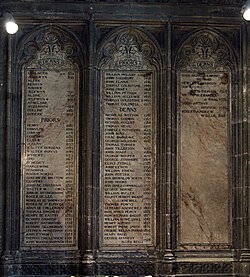
The Dean of Canterbury is the head of the Chapter of the Cathedral of Christ Church, Canterbury, England. The current office of Dean originated after the English Reformation, although Deans had also existed before this time; its immediate precursor office was the prior of the cathedral-monastery. [1]
Contents
The current dean, David Monteith was installed on 17 December 2022, [2] and is the 40th Dean since the Reformation, though the position of Dean and Prior as the religious head of the community is almost identical so the line is unbroken back to the time of the foundation of the community by Saint Augustine in AD 597. The previous Dean, the Very Rev. Robert Willis, was appointed in 2001 and retired on 16 May 2022, a day before his 75th birthday. [3]